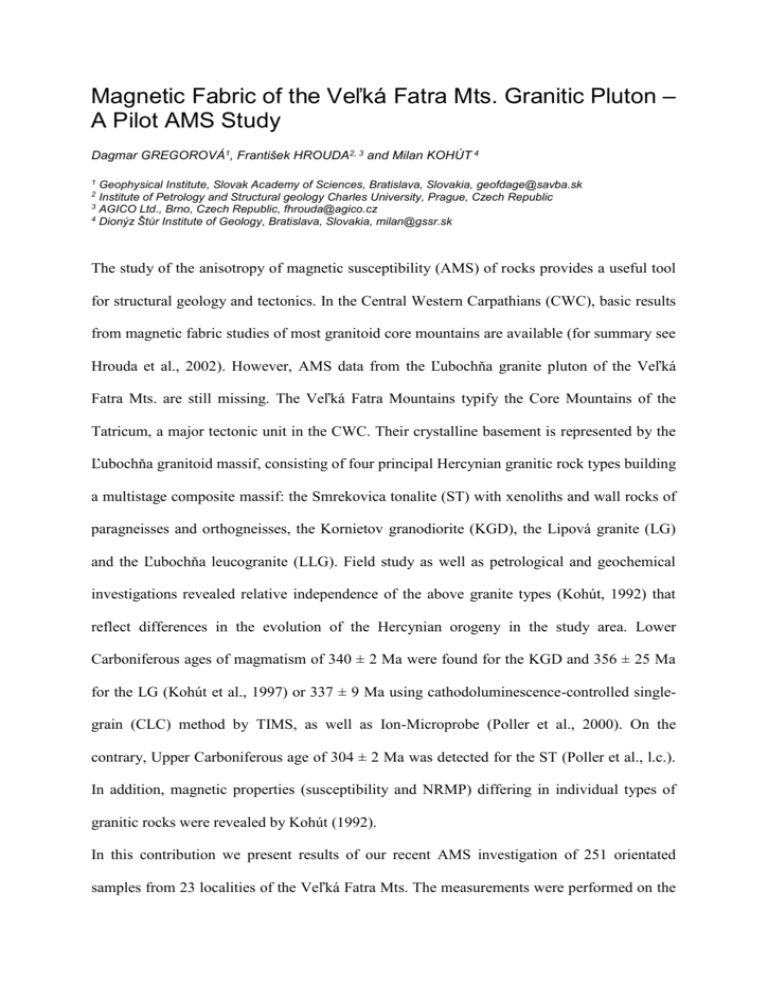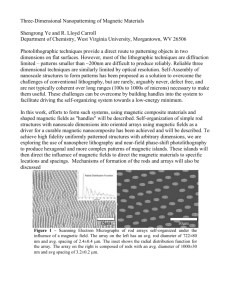The Magnetic Fabric of the Veľká Fatra Mts
advertisement

Magnetic Fabric of the Veľká Fatra Mts. Granitic Pluton – A Pilot AMS Study Dagmar GREGOROVÁ1, František HROUDA2, 3 and Milan KOHÚT 4 1 Geophysical Institute, Slovak Academy of Sciences, Bratislava, Slovakia, geofdage@savba.sk Institute of Petrology and Structural geology Charles University, Prague, Czech Republic 3 AGICO Ltd., Brno, Czech Republic, fhrouda@agico.cz 4 Dionýz Štúr Institute of Geology, Bratislava, Slovakia, milan@gssr.sk 2 The study of the anisotropy of magnetic susceptibility (AMS) of rocks provides a useful tool for structural geology and tectonics. In the Central Western Carpathians (CWC), basic results from magnetic fabric studies of most granitoid core mountains are available (for summary see Hrouda et al., 2002). However, AMS data from the Ľubochňa granite pluton of the Veľká Fatra Mts. are still missing. The Veľká Fatra Mountains typify the Core Mountains of the Tatricum, a major tectonic unit in the CWC. Their crystalline basement is represented by the Ľubochňa granitoid massif, consisting of four principal Hercynian granitic rock types building a multistage composite massif: the Smrekovica tonalite (ST) with xenoliths and wall rocks of paragneisses and orthogneisses, the Kornietov granodiorite (KGD), the Lipová granite (LG) and the Ľubochňa leucogranite (LLG). Field study as well as petrological and geochemical investigations revealed relative independence of the above granite types (Kohút, 1992) that reflect differences in the evolution of the Hercynian orogeny in the study area. Lower Carboniferous ages of magmatism of 340 ± 2 Ma were found for the KGD and 356 ± 25 Ma for the LG (Kohút et al., 1997) or 337 ± 9 Ma using cathodoluminescence-controlled singlegrain (CLC) method by TIMS, as well as Ion-Microprobe (Poller et al., 2000). On the contrary, Upper Carboniferous age of 304 ± 2 Ma was detected for the ST (Poller et al., l.c.). In addition, magnetic properties (susceptibility and NRMP) differing in individual types of granitic rocks were revealed by Kohút (1992). In this contribution we present results of our recent AMS investigation of 251 orientated samples from 23 localities of the Veľká Fatra Mts. The measurements were performed on the KLY-3S Kappabridge (Jelínek and Pokorný, 1997). Bulk magnetic susceptibility of the ST (84 samples / 8 localities) is the highest among all the rocks investigated. It ranges from 326 × 10-6 to 5,270 × 10-6 [SI] with the mean value being 2,200 × 10-6 [SI], suggesting I-type character of this granitoid. Bulk magnetic susceptibility of the KGD (67 samples / 6 localities) ranges from 46 to 3,960 × 10-6 [SI] with the mean value being 620 × 10-6 [SI] and lying within the susceptibility range of S-type granites. Bulk susceptibility of the LG (90 samples / 8 localities) is slightly lower, ranging from 23 to 1,570 × 10-6 [SI] with the main value being 160 × 10-6 [SI]. The degrees of magnetic lineation as well as magnetic foliation are relatively low in most of the samples, ranging from 1.02 to 1.05, with the foliation degree being slightly higher (1.05– 1.10) only in ST. Planar magnetic fabric prevails in all granitoid types. In the ST, the magnetic lineation forms a well-defined maximum with the mean direction oriented WSW– ENE, plunging 10° to ENE. Also the magnetic foliation poles are well concentrated with a maximum indicating NW–SE direction, and flat plunges of 10° to 20° to the NE. In the KGD, magnetic lineation forms an irregular girdle orientated NE–SW and plunging SE at moderate angles. The magnetic foliation poles form an imperfect girdle with three conjugated submaxima orientated in a NW–SE direction. In the LG, magnetic lineation forms a wellconstrained irregular girdle orientated in the NE–SW direction, plunging to the NW at a low angle. The magnetic foliation poles form a sharp anisometric maximum with a tendency to incipient steep girdle directed NW–SE. Our AMS investigations revealed slightly different magnetic fabrics in individual granite types supporting an idea of multistage pulse character of the Ľubochňa massif of the Veľká Fatra Mts. inferred from field, petrological and geochemical studies. These differences also testify that the Alpine overprint of the magnetic fabric of the Hercynian granite frequent in other parts of the Western Carpathians (Hrouda et al., 2002) was only weak, if any, in the Veľká Fatra Mts. This enables to identify the original Hercynian magmatic fabric to a large extent. The ST is interpreted as an Upper Carboniferous metaluminous intrusion of the I-type granite into the Lower Carboniferous peraluminous S-type granite of the crystalline basement. References HROUDA F., PLAŠIENKA D. and GREGOROVÁ D., 2002. Assumed Neogene deformation in the Central Western Carpathians as inferred from magnetic anisotropy investigations. EGS Stephan Mueller Spec. Publ. Series, Vol. 1: 195-211. JELÍNEK V. and POKORNÝ J., 1997. Some new concepts in technology of transformer bridges for measuring susceptibility anisotropy of rocks. Phys. Chem. Earth, 22: 179-181. KOHÚT M., 1992. The Veľká Fatra granitoid pluton - an example of a Variscan zoned body in the Western Carpathians. In: J. VOZÁR (Ed.), The Paleozoic geodynamic domains of the Western Carpathians, Eastern Alps & Dinarides. GÚDŠ Bratislava, Spec. Vol. IGCP-276, pp. 79-92. KOHÚT M., TODT W., JANÁK M. and POLLER U., 1997. Thermochronometry of the Variscan basement exhumation in the Veľká Fatra Mts. (Western Carpathians, Slovakia). EUG 9, Strasbourg, J. Conf. Abs., 2, 1, p. 494. POLLER U., TODT W., KOHÚT M. and JANÁK M., 2000. Geochemical and isotopic characteristics of the granitoids from the Velka Fatra (W-Carpathians) in combination with UPb Ion-Microprobe and TIMS Single Zircon Dating. Goldschmidt 2000, Oxford, J. Conf. Abs., 5, 2, p. 811.








